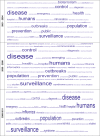The remarkable adaptability of syndromic surveillance to meet public health needs
- PMID: 23856537
- PMCID: PMC7104096
- DOI: 10.1016/j.jegh.2012.12.005
The remarkable adaptability of syndromic surveillance to meet public health needs
Abstract
The goal of syndromic surveillance is the earlier detection of epidemics, allowing a timelier public health response than is possible using traditional surveillance methods. Syndromic surveillance application for public health purposes has changed over time and reflects a dynamic evolution from the collection, interpretation of data with dissemination of data to those who need to act, to a more holistic approach that incorporates response as a core component of the surveillance system. Recent infectious disease threats, such as severe acute respiratory syndrome (SARS), avian influenza (H5N1) and pandemic influenza (H1N1), have all highlighted the need for countries to be rapidly aware of the spread of infectious diseases within a region and across the globe. The International Health Regulations (IHR) obligation to report public health emergencies of international concern has raised the importance of early outbreak detection and response. The emphasis in syndromic surveillance is changing from automated, early alert and detection, to situational awareness and response. Published literature on syndromic surveillance reflects the changing nature of public health threats and responses. Syndromic surveillance has demonstrated a remarkable ability to adapt to rapidly shifting public health needs. This adaptability makes it a highly relevant public health tool.
Keywords: Infectious diseases; International Health Regulations; Outbreaks; Public health; Syndromic surveillance.
Copyright © 2013 Ministry of Health, Saudi Arabia. Published by Elsevier Ltd. All rights reserved.
Figures
References
-
- Last JM, editor. A dictionary of epidemiology. Oxford: Oxford University Press; 2001.
-
- Nelesone T, Durrheim DN, Speare R, Kiedrzynski T, Melrose WD. Short communication: strengthening sub-national communicable disease surveillance in a remote Pacific Island country by adapting a successful African outbreak surveillance model. Trop Med Int Health. 2006;11:17–21. doi: 10.1111/j.1365-3156.2005.01534.x. - DOI - PubMed
-
- Castillo-Salgado C. Trends and directions of global public health surveillance. Epidemiol Rev. 2010;32:93–109. - PubMed
-
- Lombardo JS. The ESSENCE II disease surveillance test bed for the national capital area. Johns Hopkins APL Tech Dig. 2003;24:327–34.
Publication types
MeSH terms
LinkOut - more resources
Full Text Sources
Other Literature Sources
Medical
Miscellaneous


